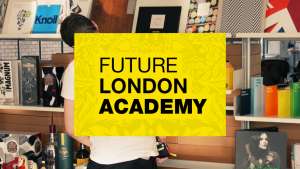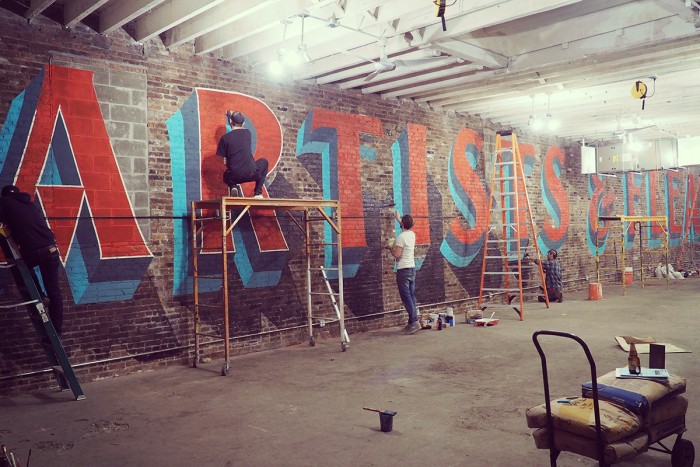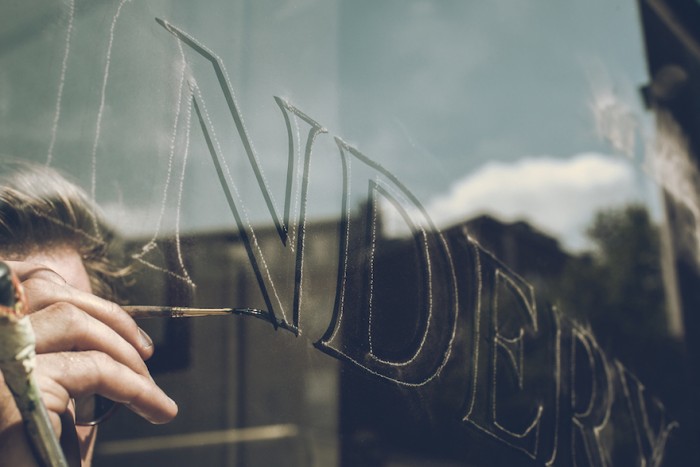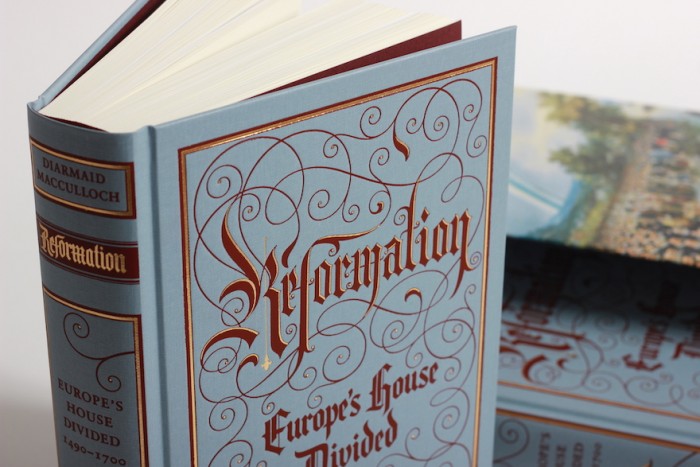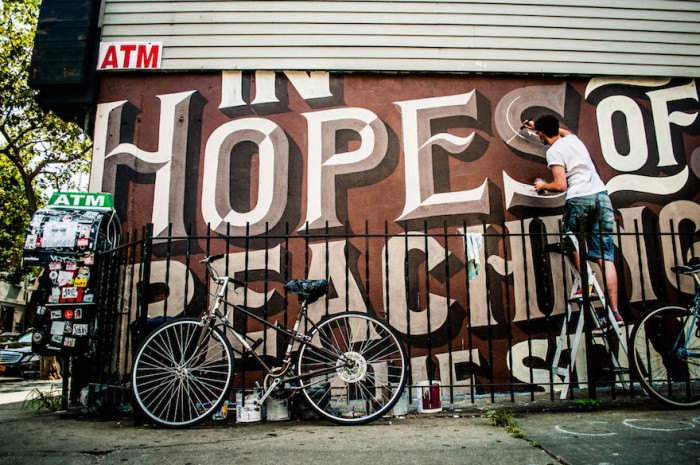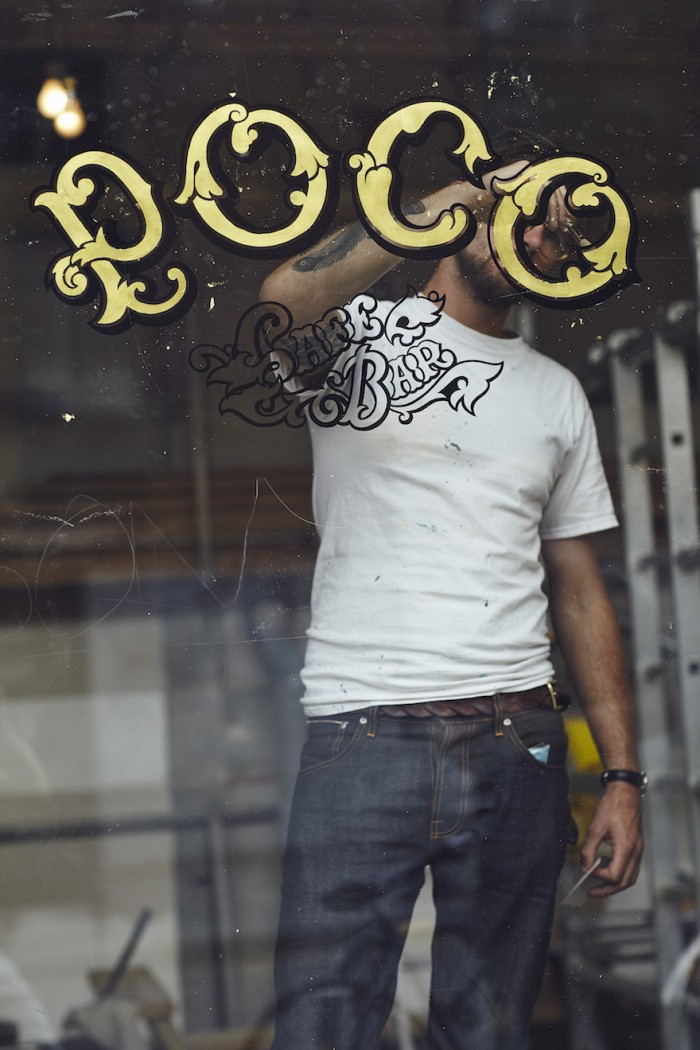From the Series
British designer Ged Palmer is a custom letter artist and sign painter, a rare craft in a digital age. Spending his time doing work that he thoroughly enjoys, Palmer plays with new styles and techniques in his studio and his work has been used by several interesting clients, including Aesop, Clarks, The Folio Society, Microsoft, National Youth Orchestra of GB, Philips, and ZSL London Zoo.
From the detail of book jackets to huge murals, Palmer enjoys the variety between delicate work wrist work and work that requires the movement and strength of his whole body. We chat to Palmer about what being a lettering artist involves.
How did you get into being a lettering artist?
I've been drawing letters pretty much every day since I was about 15. It started as an obsession with comic books, cereal packets, album covers, skateboard graphics, graffiti. Later I found myself specialising in typography whilst studying graphic design and I though I got really into the history of letterforms I was still hankering for a way to work with my hands. Moving from 'drawing letters' to making a career out of it was a lot to do with the help and encouragement of other lettering artists I was lucky enough to meet and also just a whole heap of time at the drawing table.
And what does being a lettering artist involve?
As a lettering artist you are focusing on drawing letters, custom for each job. I like to make a clear distinction that lettering is about “drawing” letters, whereas calligraphy is writing letters, typography is the arrangement of typefaces etc etc. I practice calligraphy to understand lettering and since starting out as a sign painter in 2012 I am working almost purely analog with drafted lettering sketches and hand-painted/ gilded signs.
Describe your process.
I like to meet folks face to face where possible. I don't like getting mood-boards and references, I prefer a blank slate. I spend a lot of my down time reading and playing with ideas, which means I don't tend to look at reference material when I actually do the designs, but rather pull from my experience and try to present just one option – the first idea is almost always the best! Following that I work with the client to refine the design and then get the brushes out and get to work.
How stained are your fingers?
I'm not to bad these days but when I was starting out I used to pour paint all over my shoes when I was concentrating on the brush.
Who are your clients?
I've been lucky to work with some amazing companies like The Folio Society, The Guardian, Clarks, Nudie Jeans, Microsoft. I get a lot out of working with independent shops and restaurants because the owners are really passionate and the work really becomes part of their business and hopefully brings some character to the neighbourhood.
Is most of your work commercial, or do you create personal pieces?
I feel super lucky to have found a way to make a living doing what I love. On most days I hang out at the workshop and play with ideas when I am done with client work. I think it's really important to have at least an hour a day to just be making stuff for the hell of it, sometimes it's crap and other times you stumble across a style or technique that you can't wait to use on a job.
I see you’ve done some murals - do you enjoy doing work at scale?
Making large scale work is great. It's crazy to think that some of the really fine work is about using your hand and wrist to make millimetre marks and other times your using your whole arm and shoulder to get a line or curve. it's good to mix it up and try to let your body's movements to do the work.
Are you a perfectionist? Do you enjoy the detail?
It's a funny one that. After working with logotypes for a number of years, I was so caught up on the tiniest of details about the form of letters and the balance of positive and negative space. It's great to have an eye for that kind of detail but when it comes to sign painting you can spend ages trying to dial in a tiny bit and then you stand on the other side of the road and wander what the hell you were worrying about. With sign painting my main aim at the moment is just to paint faster, faster, faster.
It's often better to go for it in a single stroke and leave it than trying to labour a line too much. It's really freeing to embrace the wobbles a bit and make the sign a bit more lively rather than getting too mechanical with it.
Why the interest in the hand drawn over design on a machine? What do you think the differences are?
Aesethetic reasons aside I think making work by hand is a lot about peace of mind. Once you're working on sketches or painting you can easily fly through eight hours work without any distraction and then you have something real to show for it at the end of the day. Working on the computer has it's uses but I like to think with a pencil in my hand.
How easy is it to correct mistakes?
There is no "undo" button with painted work, you just gotta wipe it off and start over. Sometimes your working on surfaces that mean you can't really remove the work you've done so it does help build a conviction of just going for it.
Do you ever use digital tools?
If I'm working on a book cover, logotype or some kind of special print thing then I will make vector artwork. Also for big sign jobs I will clean up sketches and adjust compositions but less and less these days. It's really great to turn up to smaller jobs with just brushes and a wax pencil for the layout!
What is the biggest challenge in your work?
A lot of people get in touch with sign painters with their designs ready to go. Many are surprised that the painters do designs too and in all truth the older sign painters are some of the best 'designers' out there! So that's a challenge, to find clients who want to go the whole nine and get the designs drawn up and then painted.
Is there something quintessentially “British” about any typefaces or styles that you can describe?
I love London for all the classic gilded pub mirrors and old lettering styles you see at shops such as James Smith & Sons. There is a lot of tendency towards more formal lettering styles like Roman and copperplate. I'm interested in early penman like George Bickham, folk lettering styles from narrow boats, stone carving by Eric Gill... I'm not sure I can describe exactly what defines these but they all feel very "British" to me.
Have you noticed any differences in style (or demand from the client) when you work abroad?
Absolutely! I've been working with a Paris based coffee roaster named Belleville for the last three years and there is such a rich history of lettering and sign painting there. Movements like Art Nouveau and Art Deco and also the letterers who have made work in the city have given the designs a really strong character.
What advice would you give young designers and artists?
My first piece of advice to anyone interested in lettering and sign painting is first to get a basic understanding of calligraphy. Buy a speedball book and some pens. Learn brush scripts, pointed pen scripts, black letter, roman, italic, etc etc. Learn these fundamentals and then when you come to draw or paint you will have an understanding of how the forms are dictated by the tools. Other than that, the most important thing is practice and have fun with it!
Palmer will be presenting a workshop at the Future London Academy's British Typography and Branding Week in London 27 June to 3 July. For more information go to the Future London Academy website.

